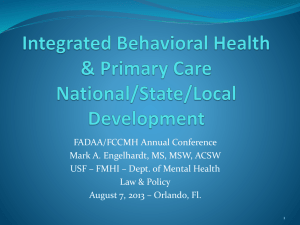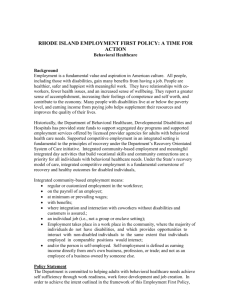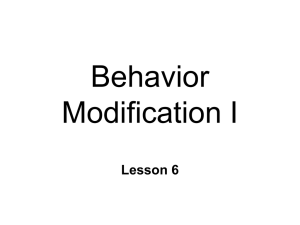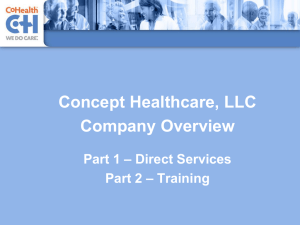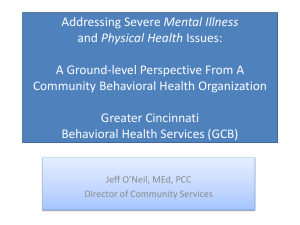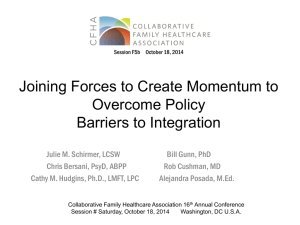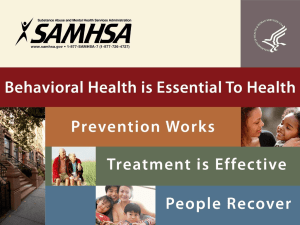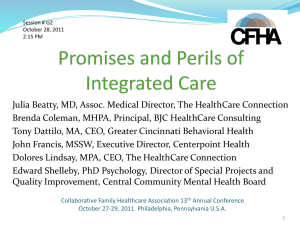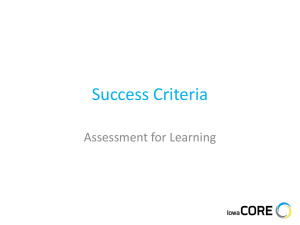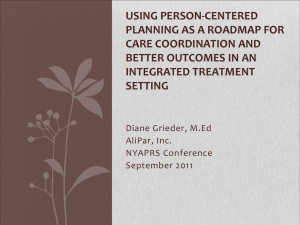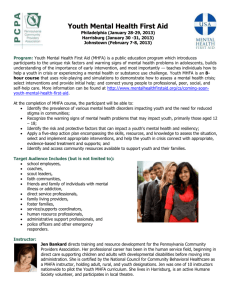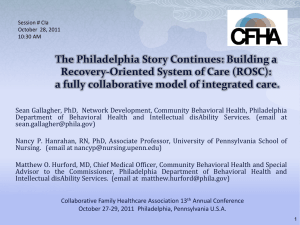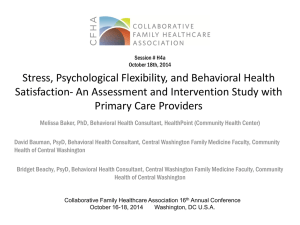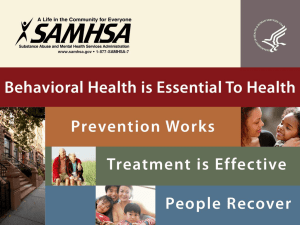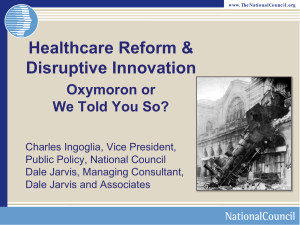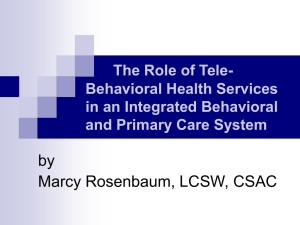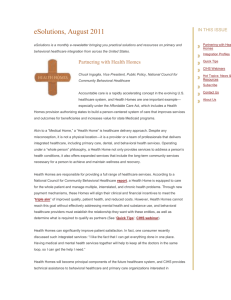Integrated Behavioral Health & Primary Care National/State
advertisement
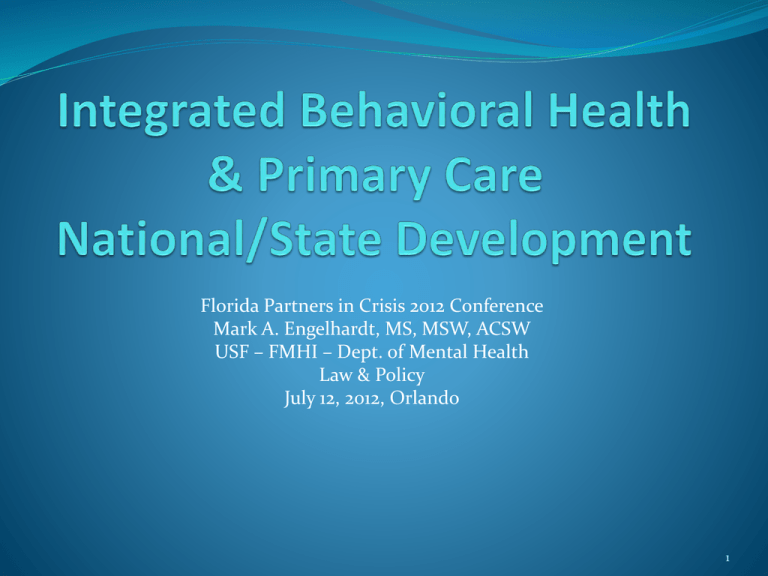
Florida Partners in Crisis 2012 Conference Mark A. Engelhardt, MS, MSW, ACSW USF – FMHI – Dept. of Mental Health Law & Policy July 12, 2012, Orlando 1 The Case for Integrated Care People with mental health and substance abuse disorders die years earlier that the average person, mostly from untreated and preventable chronic illnesses like hypertension, diabetes, obesity and cardiovascular disease. Poor health habits, such as inadequate physical activity, nutrition, smoking and substance abuse Barriers to primary healthcare & complex systems Solution – Integrated behavioral (SAMH) and primary healthcare produces better outcomes for people with complex needs involved in multiple systems of care. Quality of Integrated Care & Cost to Person/System 2 Organizational Support (2003-12) World Health Organization Substance Abuse and Mental Health Service Administration (SAMHSA) Health Resources Services Administration (HRSA) National Council for Behavioral Healthcare – Community Mental Health Centers and Integrated Substance Abuse Providers Community Health Centers – Federally Qualified Health Centers (FQHC’s) Health & Behavioral Healthcare Advocates 3 SAMHSA – HRSA Solutions Target = People with Serious Mental Illnesses 64 Current SAMHSA-HRSA Primary Behavioral Health Care Integration grants Center for Integrated Health Solutions – National Technical Assistance http://www.integration.samhsa.gov Supplemental Health Information Technology (HIT) One Year Grants to supports the development of Electronic Health Records (HER) with grantees 30 PBHCI Grant applications to be awarded in 2012 4 Grantee Evaluation: Rand Corp. 56 Grantees included in the National Evaluation 67% Partnered with FQHC’s Over 12,000 served since 10/1/09 Outcome (Data), Process and Model Evaluation 78% of Grantees are urban programs in 26 states Use of Evidenced-based practices Challenges - Data, recruiting staff and consumers, licensing, info-sharing 1% arrested in past 30 days; 63% in stable housing 5 Southeast Learning Community Six (6) Florida Grantees Miami Behavioral Health Apalachee Center – Tallahassee Coastal Behavioral Healthcare – Sarasota Lakeside Behavioral Healthcare – Orlando Lifestream Behavioral Healthcare - Leesburg Center – Miami Community Rehabilitation Center – Jacksonville Others in Region 3 = Cobb/Douglas – Georgia Tri-County CMH/State of South Carolina Norfolk, Va. (CSB) 6 Four Quadrant Model Population Based (NCCBH) Population with low to moderate risk/complexity for both behavioral and physical health issues 2. High Behavioral health risk/complexity and low to moderate physical health risk/complexity 3. Low to moderate behavioral health risk/complexity and high physical health risk/complexity 4. High risk and complexity I for both behavioral and physical health ( SAMHSA – HRSA Grant focus) 1. 7 Integration Models (A Few) Primary Care in Behavioral Health Settings; Behavioral Health in Primary Care Settings or Bi-Directional Patient-Centered Health Homes (Approach, Not a Physical setting) – Integrated Treatment Planning Chronic Care – Disease Management Models Improving Mood – Promoting Access to Collaborative Treatment – IMPACT – Early Evidenced-based Cherokee Health Systems – Fully Integrated (Tenn.) Range: Coordinated – Co-Located – Integrated 8 Workforce Issues Peer Support Specialists Shared Decision Making – Person Driven Nursing – Physicians Assistants Access to Psychiatry; Outpatient SAMH Treatment Training – On-line, Certificate Programs (UMASS); Numerous Webinars; Cross-training among disciplines, attitudinal changes; case and care management models; Recovery-oriented care Recruitment and retention Cultural proficiency 9 Clinical Considerations Screening Tools ( I.E. SBIRT – Screening, Brief Intervention & Referral to Treatment) Health Indicators ( Substance use, tobacco, blood pressure, cholesterol, weight, nutrition, etc.) Motivational Interviewing Medication Assisted Treatment – Pharmacology Pain Management Trauma 10 PBHCI Programs Million Heart Campaign – National HHS campaign to prevent 1 Million heart attacks & strokes in 5 years Wellness programs = Strategies – Education, healthy eating, physical activity, stress management, recovery processes, peer support, diabetes management, etc. Tobacco cessation Substance abuse prevention/relapse Targeted populations = homeless, drop-in centers, “housing is healthcare”, in-vivo. Interns , students, volunteers, existing programs 11 Administration & Operations Memorandum of Understanding with partners (I.E. FQHC’s) – Array of services ; who will provide what? Contracts and formal agreements Clarify Billing Opportunities and Revenue Sources – Grants, Medicaid, Medicare, Physical Health & Behavioral Healthcare – Now & Future (Affordable Healthcare Act – Prospective) Health Information Technology – Electronic Health Records – Confidentiality & Integration Meaningful Use & Data Analysis 12 COMPASS PH/BH (Cline, Minkoff) Self-assessment Tool Integrated Treatment Program Philosophy Administrative Policies Quality Improvement & Data Access to Care Screening & Identification Integrated Assessment Program & Relationships Welcoming Policies Medication Management Integrated Discharge & Transition Planning Program Collaboration & Partnerships Staff Competencies 13 Contact Information mengelhardt@usf.edu 813-974-0769 (Direct Line) USF – Florida Mental Health Institute (FMHI) – Department of Mental Health, Law & Policy http://mhlp.fmhi.usf.edu www.floridatac.org Thank You 14
